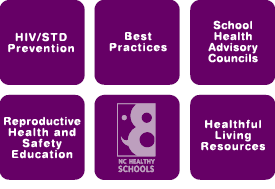In 1995, North Carolina passed
G.S. 115C-81 (e1)1 that requires public schools to offer an abstinence until marriage program. The legislation contains general
guidelines2 for instruction regarding abstinence until marriage and sexually transmitted diseases, including HIV/AIDS. Federal Title V abstinence funds are available to school systems in North Carolina to enhance abstinence education programs through planning and implementation. In addition to the state law, school systems that accept these funds must comply with the federal
A-H Criteria3 for abstinence education. To be eligible for Title V, schools systems and charter schools must provide instruction to at least one of grades 7 through 12. School allotments
4 are determined by the number of grades 7 through 12 and the number of students in these grades.
Contact Sarah Langer, Abstinence and Evaluation Consultant if you have any questions.
North Carolina Legislation G.S. 115C-81 (e1) guidelines
| Present factually accurate biological or pathological information that is related to the human reproductive system; |
| Focus on the benefits of abstinence until marriage and the risks of premarital sexual intercourse; |
| Establish abstinence from sexual intercourse outside of marriage as the expected standard for all school-age children; |
| Offer positive reinforcement for abstinence; |
| Provide opportunities that allow for interaction between the parent or legal guardian and the student; |
| Assure that students are aware of the difference between risk reduction through use of contraceptives and/or condoms and risk elimination through abstinence; |
| For any instruction concerning contraceptives or prophylactics, provide accurate statistical information on their effectiveness and failure rates for preventing pregnancy and sexually-transmitted diseases, including HIV/AIDS, in actual use among adolescent populations; |
| Inform students of the current legal status of those homosexual acts that are a significant means of transmitting diseases, including HIV/AIDS; |
| Assure that students understand that a mutually faithful, monogamous, heterosexual relationship in the context of marriage is the best lifelong means of avoiding diseases transmitted by sexual contact, including HIV/AIDS; |
| A |
has as its exclusive purpose, teaching the social, psychological, and health gains to be realized by abstaining from sexual activity; |
| B |
teaches abstinence from sexual activity outside of marriage as the expected standard for all school age children; |
| C |
teaches that abstinence from sexual activity is the only certain way to avoid
out-of-wedlock pregnancy, sexually transmitted diseases, and other associated health problems;
|
| D |
teaches that a mutually faithful monogamous relationship in the context of marriage is the expected standard of human sexual activity; |
| E |
teaches that sexual activity outside of marriage is likely to have harmful psychological and physical effects; |
| F |
teaches that bearing children out-of-wedlock is likely to have harmful consequences for the child, the childs parents, and society; |
| G |
teaches young children how to reject sexual advances and how alcohol and
drug use increases vulnerability to sexual advances; and
|
| H |
teaches the importance of attaining self-sufficiency before engaging in sexual activity. |
*It is not necessary to place equal emphasis on each element of the definition; however, a project may not be inconsistent with any aspect of the abstinence education definition.
Links:
Visit the following websites for more information about abstinence
2004-2005 Abstinence Notice of Grant Award
2005 Abstinence Supplemental Grant RFA
Not Me, Not Now:
www.notmenotnow.org
National Abstinence Clearinghouse:
www.abstinence.net
NC Department of Health and Human Services
www.epi.state.nc.us/epi/hiv/surveillance.html
Youth Development
www.youthdevelopment.org
Truth for Youth
www.truth-4-youth.org/index_flash.php
Say No Way
www.saynoway.net/index.html
The Medical Institute
www.medinstitute.org
Others:
www.abstinenceedu.com


![]()
![]()


